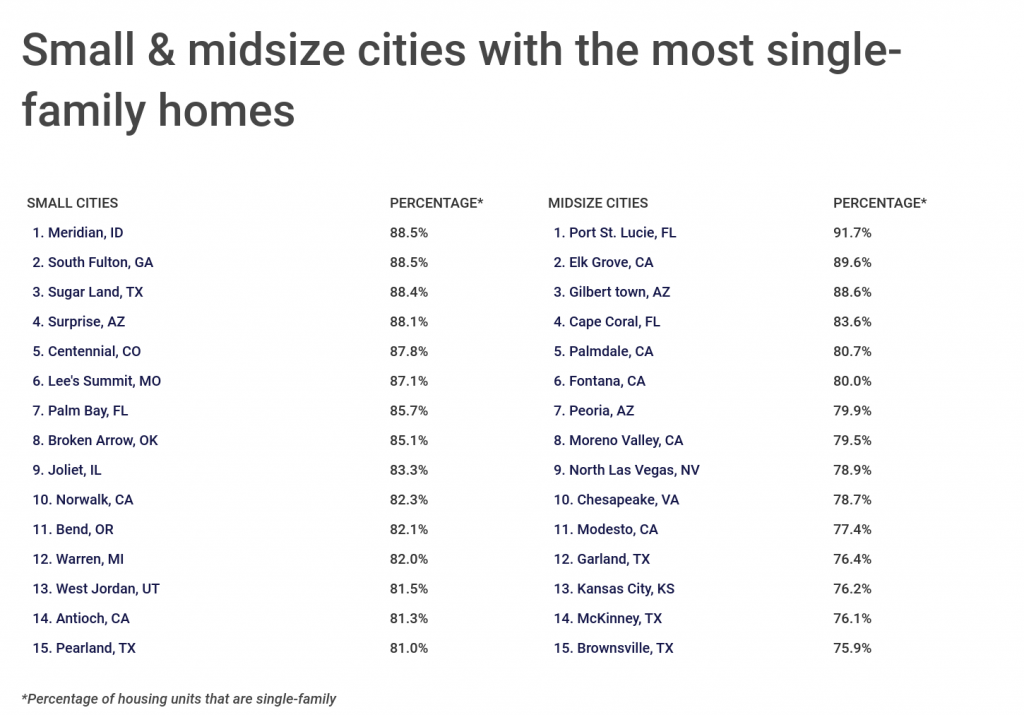In recent years, the city of Fate, Texas, has experienced rapid growth and development, much like many other cities across the United States. This growth has sparked a debate about the future of housing in Fate, with some advocating for more multi-family housing options to accommodate the increasing population.
However, it is crucial to examine the experiences of other cities that have maintained a predominantly single-family zoning approach to determine whether Fate should follow suit. This analysis will draw on data from the U.S. Census Bureau and case studies from cities like Port St. Lucie, Elk Grove, Meridian, and the City of South Fulton to argue that Fate can thrive with a predominately single-family zoning policy.

Large City Examples:
Port St. Lucie, Florida: The Pinnacle of Single-Family Living
Port St. Lucie, Florida, stands as a shining example of a city that has thrived with a predominantly single-family zoning approach. According to the 2020 census data, this city boasts an impressive 91.7% single-family housing occupancy rate. This overwhelming preference for single-family homes has not hindered the city’s growth, as it boasts a population of 204,851 residents, making it the seventh-largest city in Florida.
The success of Port St. Lucie can be attributed to various factors, including its spacious neighborhoods, well-maintained public spaces, and a strong sense of community. With a population density of 1,718.32 people per square mile, it demonstrates that a single-family dominated city can accommodate a substantial population without sacrificing quality of life.
Elk Grove, California: Striking a Balance
Elk Grove, located just south of the state capital of Sacramento, California, provides another compelling case study for the benefits of single-family zoning. The 2020 Census data reveals that Elk Grove is 89.6% single-family housing, indicating a strong preference for this type of accommodation among its 176,124 residents.
The city has achieved a population density of 4,190.44 people per square mile while maintaining an enviable quality of life. Elk Grove demonstrates that it is possible to strike a balance between accommodating a growing population and preserving the benefits of single-family living.
Small City Examples:
Meridian, Idaho: A Small City with Big Results
Meridian, Idaho, with a population of 117,635 as of the 2020 census, stands as the second-largest city in Ada County and Idaho as a whole. Despite its smaller size, Meridian maintains a substantial 88.5% single-family housing occupancy rate.
The city has achieved an impressive population density of 3,462.9 people per square mile, dispelling any notion that single-family zoning inhibits growth. Meridian’s commitment to preserving the character of single-family neighborhoods while accommodating a growing population demonstrates the viability of this approach for cities of various sizes.
City of South Fulton, Georgia: A Testament to Tradition
The City of South Fulton, Georgia, maybe one of the state’s newest cities, but it has quickly become the eighth-largest by population, with 107,436 residents as of 2020. It is important to note that this city has maintained a single-family housing occupancy rate of 88.5%, emphasizing its commitment to traditional housing.
Despite this dedication to single-family living, the City of South Fulton has achieved a population density of 1,260.7 people per square mile. This exemplifies that even in sparsely populated areas, single-family zoning can coexist with growth and development.
Fate, TX: Lessons from the Case Studies
Considering these examples of cities that have successfully maintained predominantly single-family zoning, it is essential for Fate, Texas, to reflect on its own growth and development strategy. Fate has the potential to thrive as a single-family dominated city, preserving the unique character and sense of community that its residents cherish.
Obviously, Fate has a long way to go to even reach the smallest of the “small” cities illustrated in the data. With a population of 17,958 in 2020 and a relatively modest land area of 12.4 square miles, Fate may not yet match the population figures of some larger cities in our study. However, it’s crucial to acknowledge that Fate’s potential lies not only in sheer numbers but in its ability to foster a strong sense of community and preserve the qualities that make it an attractive place to call home. By drawing inspiration from successful single-family dominated cities, Fate can chart a course that ensures its growth aligns with the vision of its residents.
The U.S. Census Bureau data and the case studies from Port St. Lucie, Elk Grove, Meridian, and the City of South Fulton provide valuable insights into how Fate can achieve this vision. While multi-family housing options can be beneficial in certain contexts, it is crucial to weigh the long-term benefits of single-family zoning, including:
- Community Cohesion: Single-family neighborhoods tend to foster a stronger sense of community and neighborly bonds, contributing to overall resident satisfaction and quality of life.
- Property Values: Research has shown that single-family homes often have higher property values, which can benefit homeowners and the local tax base.
- School Quality: Single-family neighborhoods are often associated with better-performing schools, attracting families and enhancing educational opportunities for children.
- Lower Crime Rates: Studies have indicated that single-family neighborhoods tend to have lower crime rates, making them safer places to live.
- Infrastructure Sustainability: Single-family zoning may lead to more manageable demands on infrastructure, reducing maintenance costs for the city.
Fate, Texas, stands at a crossroads, facing the decision of whether to prioritize single-family zoning or embrace multi-family housing options to accommodate its growing population. The examples provided by cities like Port St. Lucie, Elk Grove, Meridian, and the City of South Fulton highlight the viability of a predominantly single-family approach.
These cities demonstrate that single-family zoning can coexist with growth, resulting in strong, cohesive communities, stable property values, and quality education opportunities. As Fate plans for its future, it should carefully consider the lessons from these case studies and the preferences of its residents to make an informed decision that will shape the city’s destiny for years to come.

